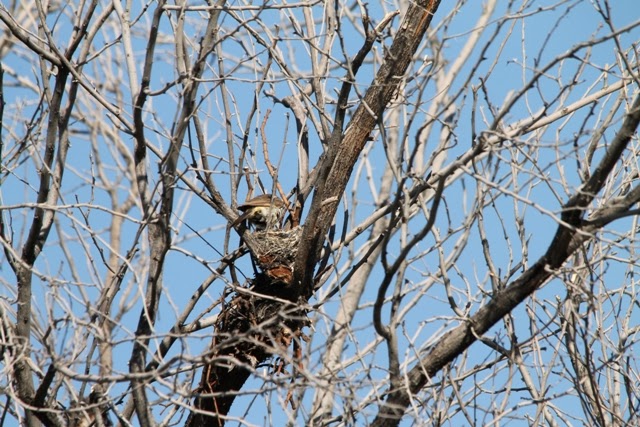Lucy’s Warblers are a species of conservation concern here in Nevada. A small, cavity-nesting warbler, in Nevada they’re found primarily in riparian areas and mesquite woodlands. They typically nest between 0.6 and 6m above ground, in a wide variety of locations, from crevices formed by loose bark, to natural cavities, to old woodpecker cavities – even (rarely) crevices or burrows in rocks or banks [1].
Okay, on to pictures!
This first one exemplifies the nests that were in the burned screwbean mesquites, with the Lucy’s Warblers building in “cavities” created by peeling bark.
The next 3 pictures show Lucy’s Warbler nest locations behind peeling bark in burned-over cottonwoods. In the third set, this nest was located in the same tree as a Western Kingbird nest. The Kingbirds lived up to their genus name, Tyrannus, and were very territorial. On one occasion, I watched the Kingbirds prevent the Lucy’s Warbler pair from bringing food to their nestlings for over 3 minutes (and I’d arrived in the midst of their dispute and been watching for some time before I thought to look at my watch!).
This nest location in a burned cottonwood was featured in a previous post, and the nesting attempt was evidently abandoned. Two other species began nesting in this snag, as well: Brown-crested Flycatcher, and Western Kingbird. These also abandoned their attempts. This could be chance (I did see several other nesting attempts by Lucy’s Warblers and Western Kingbirds that didn’t go anywhere), or perhaps the lack of shading from any other vegetation led to it being too hot, or [insert your explanation here!]. On the other hand, it was the most heavily-used perch tree on my plot, by a wide variety of species!
Below is a Lucy’s Warbler nesting site behind some peeling bark of a burned-over cottonwood that is resprouting. This tree served as a nest site for 2 successive years; in the second year, the new growth had become tall enough to hide the site from view.
Last, but not least, is a Lucy’s Warbler nest location within a natural cavity within an ash. I had walked by this location numerous times during my surveys, without realizing the nest was there – on this survey, the pair was bringing food, and the nestlings were creating a racket! (You can see feces on the nest’s rim, from either older nestlings or the female.)
- Jen





















